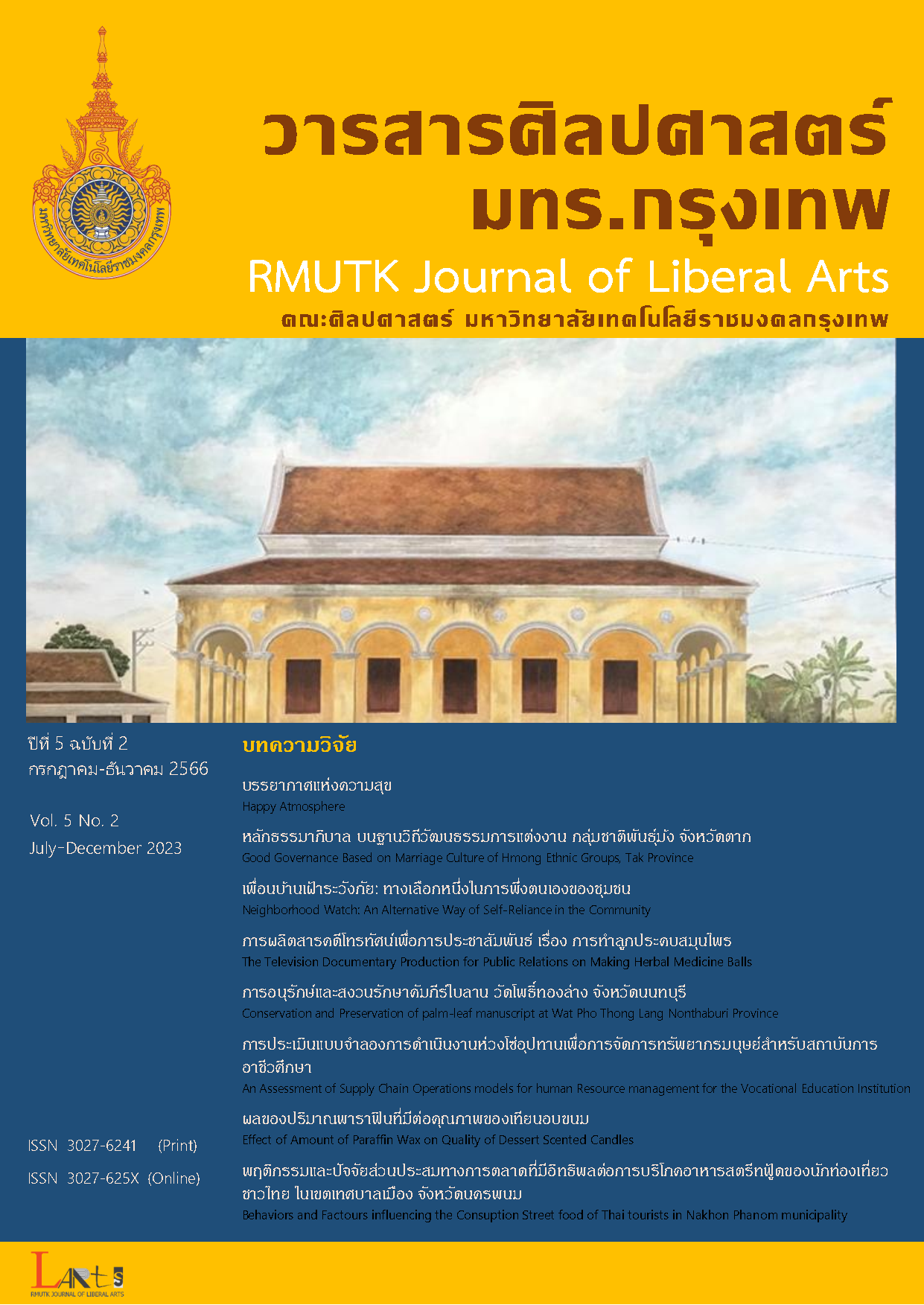Effect of Amount of Paraffin Wax on Quality of Dessert Scented Candles
Main Article Content
Abstract
The purpose of this study was to investigate the effect of paraffin concentration on the quality of dessert scented candles. A research goal focuses on investigating the standard dessert-scented candle formula as-well-as the suitable proportion of paraffin in dessert-scented candle production. This study's samples included lecturers, staff, and the student 30 people from the Rajamangala University of Technology Krungthep. The sensory quality of the aroma of dessert-scented candles in Mung Bean Dessert (Thua Kwan) was used to select standard formulas for dessert-scented candles. The first dessert-scented candle formula resulted in liking scores for scent, taste, texture, on overall liking from the two dessert-scented candle formulas. The paraffin wax ratings were higher than the Formula 2 dessert-scented candles. For dessert-scented candles, the paraffin content was tested at three levels: 0 g (formula 1), 20 g (formula 2), and 40 g (formula 3). The sensory aspect of Mung Bean Dessert (Thua Kwan) revealed that the like scores for smell, taste, texture, and overall liking were all positive. Because the ratio of paraffin content to wax content differed, the formula 2 had the highest mean score of the smoked Mung Bean Dessert (Thua Kwan), which by Formula 1 and Formula 3, respectively. As a result, the smell of the dessert made with each candle recipe is unique.
Article Details

This work is licensed under a Creative Commons Attribution-NonCommercial-NoDerivatives 4.0 International License.
References
คนรักไม้ดอกหอมและเครื่องหอมไทย. (2563, 10 กรกฎาคม). การทำเทียนอบ. เฟซบุ๊ก.https://www.facebook.com/618245741648114/videos/3987545674654167
ชยันต์ พิเชียรสุนทร. (2545). คู่มือเภสัชกรรมแผนไทย เล่ม 2. อัมรินทร์.
ชยันต์ พิเชียรสุนทร, แม้นมาส ชวลิต, และวิเชียร จีรวงส์. (2548). คำอธิบายตำราพระโอสถพระนารายณ์. อมรินทร์.
นวลปรางค์ ฉ่องใจ. (2546). สุวคนธบำบัด และเครื่องหอมจากสารสกัดธรรมชาติ. กำแก้ว.
ปทุมทิพย์ ต้นทับทิมทอง, และ นันทวัน กลิ่นจำปา. (2557). การพัฒนาการผลิตน้ำอบไทย. โครงการวิจัยทุนสนับสนุนงานวิจัยมหาวิทยาลัยเทคโนโลยีราชมงคลกรุงเทพ.
ปทุมทิพย์ ต้นทับทิมทอง, นันทวัน กลิ่นจำปา และไชยยันต์ ไชยยะ. (2551). การพัฒนาวิธีการอบควันเทียน. โครงการวิจัยทุนสนับสนุนงานวิจัยมหาวิทยาลัยเทคโนโลยีราชมงคลกรุงเทพ.
ปิยะธิดา สีหะวัฒนกุล, และกิตติ ยอดอ่อน. (ม.ป.ป.) เทียนอบ. มหาวิทยาลัยเทคโนโลยีราชมงคลพระนคร.
มาตรฐานผลิตภัณฑ์ชุมชน. (2548). เทียนอบ. http://tcps.tisi.go.th/pub/tcps988_48.pdf
ศูนย์พัฒนาปิโตรเลียมภาคเหนือ กรมการพลังงานทหาร ศูนย์การอุตสาหกรรมประเทศและพลังงานทหาร. (2562). กระบวนการผลิตพาราฟินแว๊กซ์. https://ded.mod.go.th/CMSPages/GetFile.aspx?nodeguid=935e23c0-9add-4942-8c34-f77a0af77068&lang=th-TH
สมพร ภูติยานันต์. (2551). สมุนไพรใกล้ตัว เล่มที่ 13 ว่าด้วยสมุนไพรแต่งสี กลิ่น รส. เอราวัณการพิมพ์.
Thongon.A Pramukkul.P & Luksameevanish.V. (2019). จุดหลอมเหลว และ สัมประสิทธิ์ การ พา ความ ร้อน แบบธรรมชาติ ของ ขี้ผึ้ง พาราฟิน. RMUTP Research Journal, 13(2), 156-166.

